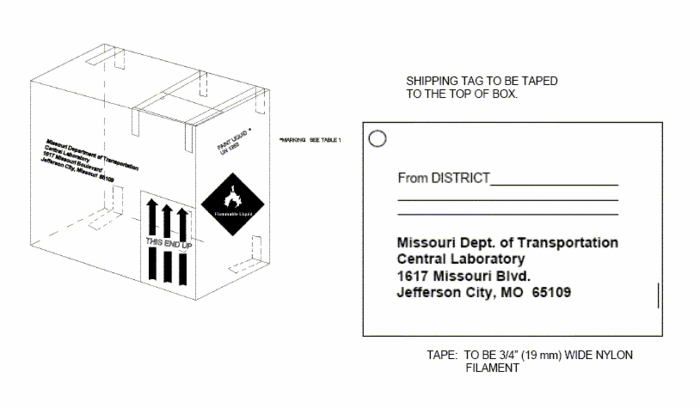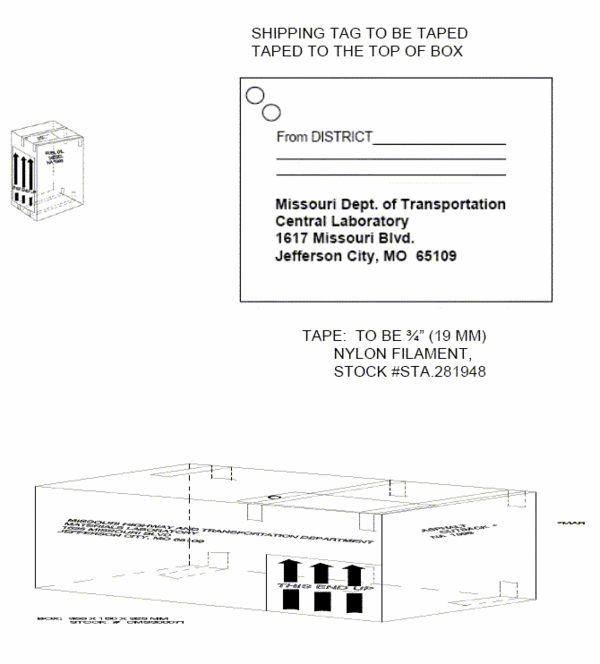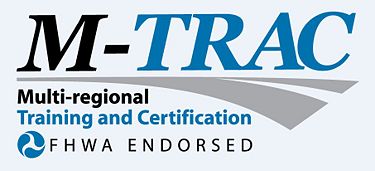106.3 Samples, Tests and Cited Specifications
| EPG 106.3.2 MoDOT Test Methods |
This article covers the procedures to be used to properly sample, identify and ship a sample. Also included in this article is a list of MoDOT test methods utilized by MoDOT and information regarding non-MoDOT test methods used for materials acceptance.
106.3.1 Sampling
106.3.1.1 Random Sampling
Careful and judicious selection of a sample cannot be overemphasized. It is the sampler's responsibility to secure a representative sample and take every precaution that it will remain representative until tested. The intent is always to obtain random samples that fully represent the characteristics of the material being sampled. Many materials are manufactured in identified lots/heats/groups, etc. indicating that the material is manufactured and identified with the same criteria and should be uniform in character. In some cases, this can aid in sampling procedures.
If an inspector is presented with an entire lot of material “X” to inspect and chooses samples, as may be the case in a warehouse, by using random sampling procedures there is assurance that the samples actually represent the character of that material. It is reasonable to report any part or all of that lot, on the basis of the random sample test results, at that time or later if the lot is believed to be uncontaminated and true. On the other hand, if the manufacturer made a lot of Brand “X” in Kalamazoo and the inspector is only allowed to see part of the lot at the fabrication shop in another location or on the construction job, as often happens with destination inspection, any sampling of that population U is not a random sample of the entire lot U. It is only a sample of the material lot that the manufacturer chose to send, i.e. a biased shipment. Therefore, it is not reasonable to assume that samples of the destination material represent the entire lot back at the factory or elsewhere, and a new shipment of the same lot requires new sampling. In the case where a shipment contains various lots or brands or other differentiation, it is not reasonable to assume that the sampling of one portion, is necessarily characteristic of the rest of the shipment.
In the true sense of random sampling, samples only represent the material that the inspector had access to at the time of sampling. Material arriving after sampling, regardless if it is a few minutes or days, is not a part of the sample population and is thus not technically represented. However, in a practical sense, sometimes it may be reasonable to assume that adjunct shipments of the same lot/heat/group are similar, when not unreasonably separated by time and interrupting manufacturing processes. Unless otherwise designated in sampling instructions, this may be considered an inspector determination provided uniform practices are followed and the highest calling is adhered to, i.e., uniform assurance of specification compliant and quality materials is mandated.
Inspectors are always within their right to sample per shipment or as necessary to assure quality and uniform materials. This article generally sets up more specific criteria for various materials in order to provide some expectation of sampling/testing uniformity, both for MoDOT as well as the supplier and the contractor. However, Sec 106, which is a part of the contractor and supplier contract with MoDOT, clearly identifies that: a) the contractor is responsible for ordering quality material, b) all material is required to meet the quality requirements of the contract and be a uniform product, c) all materials must be approved by the engineer before use and d) material is subject to inspection and rejection at any point or time, prior to or after incorporation into the work. For liquids, container lids should be fastened tightly to prevent aeration or loss of any part of the sample. Always secure the lids of liquid samples shipped in friction top cans with a minimum of 4 metal safety retaining clips. Cleanly wipe the outside of sample cans after filling and before packaging for shipment to the Laboratory. In the case of liquid samples, leave approximately ½ in. (15 mm) of air space between the top of the container and the surface of the liquid; otherwise, expansion during shipment may burst the container and cause loss of the sample.
106.3.1.2 Submission of Laboratory Samples
106.3.1.2.1 Identification
Properly identify a sample by creating an AASHTOWARE Project (AWP) sample record (see AWP MA Sample Record, General), by properly attaching the associated sample identification number to the sample, and by providing any supplemental information that may be required for the specific material being submitted. Refer to the Engineering Policy Guide article that applies to the sample material to determine what supplemental information may be required and how it is to be provided. Furnish complete and accurate information relative to the material represented to the Laboratory. This is essential in order to have the proper tests performed in the Laboratory. Mark each sample container with the proper identification number or have the appropriate tag or label attached. Do not place any identifying information on container lids. Use only approved identification tags that have been obtained from Construction and Materials.
106.3.1.2.2 Transportation of Samples
Securely wrap and package samples to ensure arrival in the Laboratory without damage. Pack metal cans that do not contain liquid samples in cardboard containers or wrap with heavy paper. Seal plastic jugs containing liquids in a zip seal plastic bag and pack in cardboard boxes with an absorbent packing material. Cloth sacks need no packaging but must be securely tied. Package, label and mark materials classified flammable or combustible for shipping as required in Table 106.3.1.4.1 List of Flammable and Combustible Materials and Paint and Paint Constituents. Examples of packaging and marking those materials are shown in Figures 106.3.1.4.1 and 106.3.1.4.2. When shipping small sample containers, such as one-quart (1 L) cans, several may be packaged together to facilitate shipment; however, all cans must be sealed in a zip seal plastic bag if they contain liquids. This practice is also desirable to minimize transportation costs.
All liquid samples must be placed into at least one layer of heavyweight, sealable plastic bags such as zip seal (ZipLoc) bags, prior to placing the samples into the proper shipping container. It is especially important that sufficient absorbent material is placed around the plastic bags to contain any leakage that might occur during shipment. When liquid samples are shipped in friction top cans, the lids must be secured with a minimum of 4 metal safety retaining clips. The safety retaining clips are stocked in two sizes, one for pint/quart cans and the other for gallon cans. Be sure to use the correct clip for the correct size container and be aware that these clips are special locking clips and require a tool such as a screwdriver to properly apply to the can. Never secure lids on friction top cans with tape. Pay particular attention to the requirements for labeling shown in Table 106.3.1.4.1 List of Flammable and Combustible Materials and Paint and Paint Constituents.
Never combine samples in the same bulk delivery container used for letter mail.
Samples are to be shipped to:
- Missouri Department of Transportation
- Central Laboratory
- 1617 Missouri Boulevard
- Jefferson City, Missouri 65109
Addressed shipping labels are available from Construction and Materials and should be used. Shipping labels from Construction and Materials are duplex labels with shipping information on one side and sample information on the other. These tags may be tied or taped to the package and are desirable since additional sample information may be filled out on the tag and should accompany the sample. Samples of material submitted to the Laboratory should be sent by MoDOT vehicles traveling from the district to the Laboratory or by the freight shipping service contracted by General Services. Other means may be utilized if these modes are not available. The judgment of the District Construction and Materials Engineer will be relied upon to select the proper mode, taking into consideration the need for safety, shipping regulations, early test results, cost involved, and convenience.
106.3.1.2.3 Rush Tests
It is often necessary to receive Laboratory results as quickly as possible. Normally, you should not request rush tests unless necessary. Send samples as far in advance as possible of the time when the material represented will be needed. When a rush test is necessary, the sampler should be guided in marking the identification sheet, by the following instructions:
- (a) If the material is needed for immediate use, mark the sample ID tag "Rush - telephone results". The Central Laboratory will complete the test as rapidly as possible and telephone the proper party.
- (b) For all other samples, no "Rush" marking is necessary. The Laboratory will complete the tests as soon as possible consistent with current work and report results in AASHTOWARE Project (AWP).
106.3.1.3 Sampling Supplies
The type of container to be used will depend on the material being sampled. Canvas material bags used for aggregate samples should be clean and free from tears or holes. Metal and plastic containers should be clean and dry to prevent any contamination.
The following supplies are available and may be obtained from the Laboratory in Jefferson City:
- (a) Used canvas materials bags (when available).
- (b) Plastic liners and small canvas bags for shipping cement samples.
- (c) Ointment cans (3 and 6 ounce)[85 and 170 grams].
- (d) Small plastic containers for paint activator components.
Obtain other sampling supplies, such as new canvas material bags, containers, metal safety retaining clips for friction top cans, and zip seal plastic bags from the district office. These supplies are among the many items listed in the Catalog of Garage Stock Items issued by General Services. Obtain shipping labels/ID tags from Construction and Materials.
Use only those supplies shown in Table 106.3.1.4.2 Supplies Required for Packaging and Shipping Flammable or Combustible Materials for packing and shipping materials listed in Table 106.3.1.4.1 List of Flammable and Combustible Materials and Paint and Paint Constituents.
106.3.1.4 Tables and Figures
- Table 106.3.1.4.1 List of Flammable and Combustible Materials and Paint and Paint Constituents
| List of Flammable and Combustible Materials | ||||
|---|---|---|---|---|
| Material Samples | Flash Point, TCC, ºF (ºC) | Packaging | Labels Required | Marking |
| Asphalt, Cutback (RC) | 0 (-18) | Two 1 qt. (liter) Screw-top Metal Containers in Zip Seal plastic bag in approved box | Flammable Liquid This End Up | Asphalt, Cutback UN1999 |
| Asphalt, Cutback (MC) | 100 (38) | Two 1 qt. (liter) Screw-top Metal Containers in Zip Seal plastic bag in approved box | This End Up | Asphalt, Cutback UN1999 |
| Diesel Fuel | 125 (52) | Two 1 qt. (liter) Screw-top Metal Containers in Zip Seal plastic bag in approved box | This End Up | Fuel Oil, Diesel NA 1993 |
| Gasoline | 0 (-18) | Two 1 qt. (liter) Screw-top Metal Containers in Zip Seal plastic bag in approved box | Flammable Liquid This End Up | Gasoline UN1203 |
| Concrete Curing Compound | 50 (10) | One 1 qt. (liter) Metal Container in Zip Seal plastic bag in approved box | Flammable Liquid This End Up | Paint, Liquid UN1263 |
| Paint and Paint Constituents | ||||
| Material Samples | Flash Point, TCC, ºF (ºC) | Packaging | Labels Required | Marking |
| Mineral Spirits | 104 (40) | One pt. (0.5 liter) Metal Container in Zip Seal plastic bag in approved box | Flammable Liquid This End Up | Naphtha, Solvent UN1256 |
| Paint | 0 (-18) | 1 qt. (liter) Metal Container in Zip Seal plastic bag in approved box | Flammable Liquid This End Up | Paint, Liquid UN1263 |
| Paint, Multiple Component | 0 (-18) | As specified in Two 1 qt. (liter) Metal Containers in Zip Seal plastic bag in approved box | Flammable Liquid This End Up |
0 [-18] As specified in FS-1045, Table 1045-1 (place in Zip Seal plastic bag)||Flammable Liquid This End Up||Paint, Liquid UN1263 |
| Paint Thinner/reducer | 0 (-18) | 1 qt. (liter) Metal Container in Zip Seal plastic bag in approved box | Flammable Liquid This End Up | Compound, Paint, Reducing or Thinning
NA1142 |
| NOTE 1: Do not combine paint, paint constituents and asphalt in the same package or with other materials. Ship all materials in an approved outside container with sufficient cushioning and absorbent material. When materials are combined in the same package, label and mark according to the material with the lowest flash point. Allow sufficient space for expansion of liquid in containers. Tightly close all containers and place upright in the shipping carton. | ||||
| NOTE 2: Multiple component paints are typically packaged in units. Each unit will include containers of each component packaged in the correct mixing proportions. When sampling this material, a unit may be ruined if each component is not sampled in the same proportions in which the unit was packaged. In this case, obtain samples of each component in the correct proportions providing that, when mixed, the combined components will create at least one quart of mixed paint for laboratory testing. Sampling containers should be compatible with the component being sampled. In most cases, lined, metal, friction-top containers are acceptable. Activator components require plastic sample containers. | ||||
- Table 106.3.1.4.2 Supplies Required for Packaging and Shipping Flammable or Combustible Materials
| Metal Containers | |
|---|---|
| Approved Packaging | Stock Number |
| Can Frict. Top, “pt” (0.5 liter)(pheonolic lined) | 3054205080 |
| Can Frict. Top, “qt” (liter)(pheonolic lined) | 3054205070 |
| Can, Screw-Top, ” qt” ([liter)(round) | 3054205090 |
| Eng. Supp. Misc. Clip Close, “Small” For (Pint/Quart) Friction Top Cans | 3054205126 |
| Eng. Supp. Misc. Clip Close, “Large” For (Gallon) Friction Top Cans | 3054205127 |
| Cardboard Containers | |
| Approved Packaging | Stock Number |
| Carton Concrete (sample)(14” X 14” X 7”) | 3054205110 |
| Carton Asphalt (new style)(11” X 11” X 3”) | 3054205095 |
| Carton Asphalt (old style)(13” X 13” X 4 1/2”) | 3054205100 |
| Carton Water-Sample (gallon)(12” X 6 3/8” X 6 3/8”) | 3054205120 |
| Filament Tape, ¾ in., (19 mm) | Obtain locally |
| Plastic Zip Seal Bags | |
| Approved Packaging | Stock Number |
| Bag Poly Zip Lock Containment (10” X 12”) | 3054205018 |
| Bag Poly Zip Lock Containment (13” X 18”) | 3054205022 |
| Shipping Labels | |
| Approved Packaging | Stock Number |
| Labels Attention, “THIS END UP” 4” X 8” | 6150101211 |
| Labels Warning, “FLAMMABLE LIQUID” 4” X 4” | 6150101217 |
| Cushioning - Use crumpled newspaper, paper toweling, rags, vermiculite absorbent, etc., to prevent movement and damage to inside containers and to absorb leakage during transit. | |


